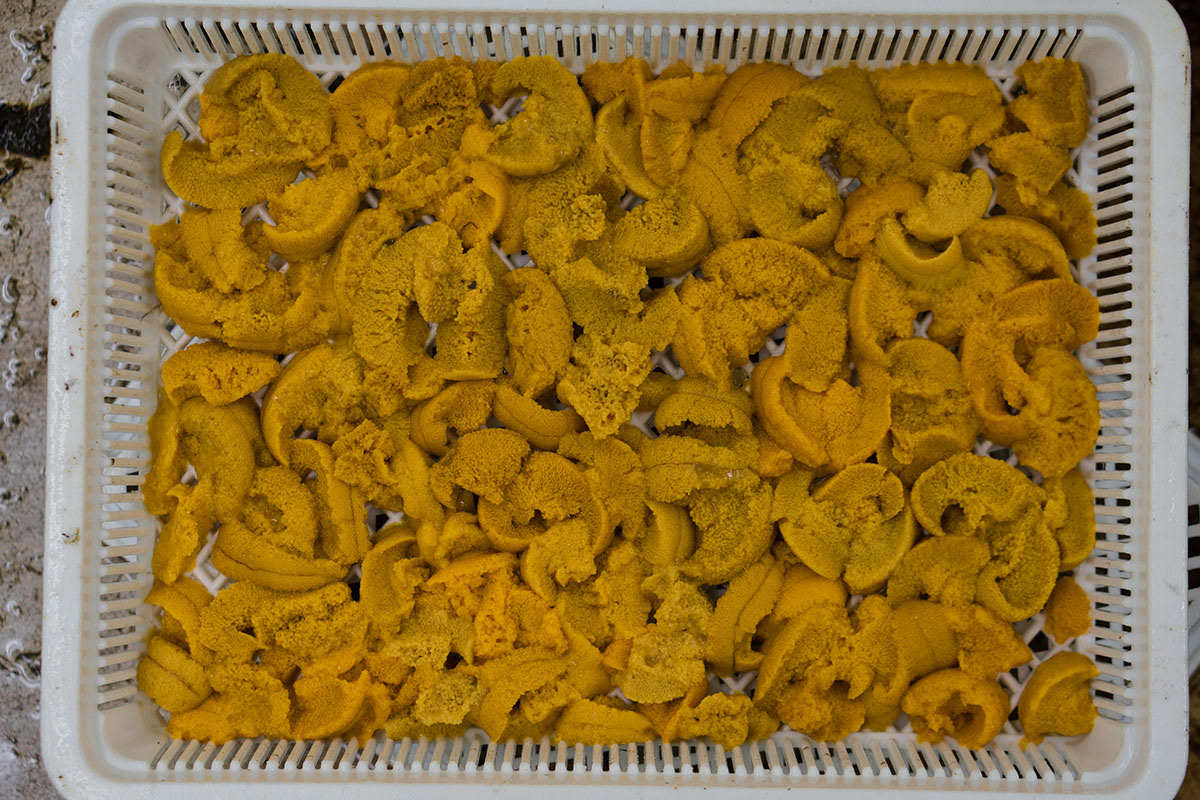Uni is one of the most luxurious and straight up delicious foods you can eat. But few people know how the Uni gets on those wooden or plastic trays. To be totally honest I didn't really know what the process was. I've been lucky enough over the years to have gone diving for Urchin and definitely consumed more than my fair share of Uni. But as for what happened between the boat and my throat I had no clue.
So I headed North where the Uni Don invited me into his facility to steal some knowledge. And act busy.
This is where it all starts! Each harvester (Diver) brings the Live Urchin to the plant in fish totes where the plant manager cracks a dozen or so Urchin to check the color and quality of the tongues. This gives him an idea of what kind of yield he'll get out of each divers harvest. And how much he'll pay for it.
Urchin are unique to their habitat. So while out Gulf of Maine Urchin are small (about the size of a baseball) and bright green Urchin from just about anywhere else on earth will look different. And of course have a much different flavor profile.
The process starts here on the shucking tables. Urchin are spread out across massive stainless steel tables. Shuckers stand on one side of the tables while the floor manager works to keep the tables full or Urchin and cracking them open from the other side.
The sounds, smells and colors are incredible. It's definitely sensory overload. The tables were covered in bright green with pops of ridiculous bright yellow/orange.
It was impossible to take a step anywhere without stepping on Urchin. With every step I felt and heard the CRUNCH! It gave me a horrible feeling every-time.
And the sound of the shucker cracking the Urchin is indescribable. Its a crushing and scraping at the same time. A weird combination of running your nails down a chalkboard and crushing a beer can. Totally unique.
Here's a couple good looks at the splitter.
Once the urchin have been split, or cracked, the next step is shuckers remove the tongues. It is really delicate work! They delicately scoop the tongues from the shell and grade based on quality (size and color).
The color of the tongues indicate the maturity and sex. Urchin are both male and female. I'm sure there's plenty of information on it for you to Google because that's well above my pay grade. The Male and Female tongues have very different flavors. The Males are more minerally while the Female are more sweet and nutty.
This first step is dirty for sure. Looking at the product here its impossible to imagine just how perfect they'll look in just about an hour.
As the tubs fill the shuckers will rinse the tongues and use fine nose tweezers to clean the tongues.
At the end of this stage each shucker has baskets of clean BEAUTIFUL uni! Each basket graded to size and color for uniformity.





The final step is packing where there's actually two options. Most of us are only familiar with Uni packaged in trays but Uni is also packed in sea water. This is called a "Wet Pack".
For a wet pack the tongues are just scooped from the rinsing tubs into containers that are filled with sea water. The idea behind this is that the tongues are not as easily damaged but more specifically it helps maintain the integrity of the Uni in shipping and storage.
Packing Uni in the traditional wooden trays takes a LOT more skill and patience! Each step of the process definitely requires refined skills but at this step it becomes very obvious those who have been shucking and packing for years.
Gulf of Maine Uni tongues are not very big. They are about half the size of West Coast Uni. So delicately packing trays of fragile Uni tongues is not easy. The speed which these trays are packed is incredible considering how delicate they are being to ensure they don't damage the tongues.